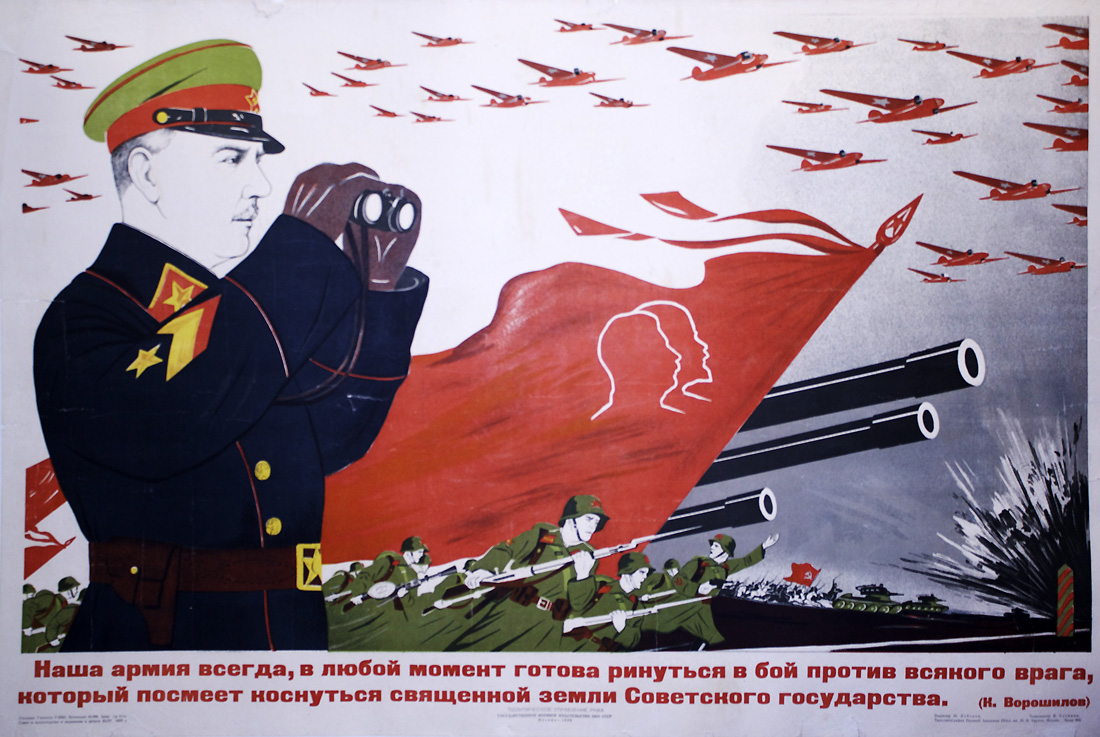
Our army always, in any moment, is ready to go into combat against any enemy who gives himself permission to touch the holy soil of the Soviet state. -K. Voroshilov.
Poster Number: PP 541
Category: Military
Poster Notes: Depicted is Kliment Voroshilov (1881-1969), Commissar of Defense. He was a Marshal of the Soviet Union (despite his reputation for being a poor strategist) before and during the U.S.S.R.’s involvement in World War II. After Stalin’s death in 1953, Voroshilov was removed from a position of direct political power.
Media Size: 39.5x27
Poster Type: Lithograph and Offset
Publishing Date: 1939
Editorial Information: Editor M. Lebedev; Technical Editor I. Ustinov
Technical Information on Poster: Voenizdat No. I-396; Submitted for production and approved for printing June 25, 1939; Order No. 664; Price 1 ruble 50 kopeks; "Artists attributed V. Deni, and N. Dolgorukov."
Glavlit Directory Number: G-2863
Catalog Notes: PP 541 Military b
Artist: Deni (Denisov), Viktor Nikolaevich — Дени (Денисов), Виктор Николаевич
Although known for his characterizations and posters that he signed with the pseudonym 'Deni'; Viktor Nikolayevich Denisov never received formal artistic education. Around 1906, Deni began exhibiting at the annual exhibitions of the Society of Independents in Saint Petersburg, as well as at the Salon of Humorists. In 1910, he took private lessons in painting and drawing from the artist-portraitist Nikolai P. Ulianov and that same year, he became active in the field of political caricature, contributing ...
Read More About This Artist
Artist: Dolgorukov, Nikolai Andreevich — Долгоруков, Николай Андреевич
In 1928, Nikolai Andreevich Dolgorukov moved from his native Ekaterinburg to Moscow to attend VKhUTEIN (Higher State Artistic and Technical Institute). After that organization dissolved in 1930, Dolgorukov continued his studies at the Moscow Polygraphic Institute under the tutelage of artists Lev Bruni and Dimitri Moor. Dolgorukov's training was in illustrated political satire as well as in poster design, and each area became the main focus of his long career. After graduation, he collaborated with fellow poster ...
Read More About This Artist
Printer: Typolithography of the Military Academy of the RKKA named for M.V. Frunze, Moscow — Типо-литография Военной Академии РККА им. М. В. Фрунзе
Mikhail Vasilyevich Frunze (1885-1925) was the People's Commissar for Military and Naval Affairs in 1925. An important Bolshevik military commander during the Russian Civil War, his name was bestowed upon the Moscow Academy of the General Staff of the Workers’ and Peasants’ Red Army (a.k.a. Red Military Academy) from 1925 to 1998. The academy was considered the training ground for up-and-coming officers and it was one of the most prestigious military educational institutes in the USSR.
Read More About This Printer
Publisher: State Military Publishing House NKO, Moscow — Народный комиссариат обороны (НКО)
The State Military Publishing House NKO (People's Commissariat of Defense) was the publishing arm of the Commissariat of Defense, the highest military department of the Soviet Union from 1934 to 1946. The NKO merged with the People's Commissariat of the Navy in 1946 to form a single entity-- the People’s Commissariat of the Armed Forces. The new organization was placed under the Ministry of Armed Forces of the USSR.
Read More About This Publisher